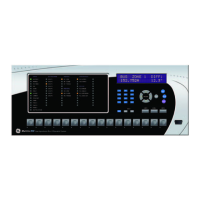CHAPTER 8: APPLICATION OF SETTINGS BIASED CHARACTERISTIC BREAKPOINTS
B90 LOW IMPEDANCE BUS DIFFERENTIAL SYSTEM – INSTRUCTION MANUAL 8-5
8
8.3 Biased characteristic breakpoints
8.3.1 Description
The limits of linear operation of the CTs need to be found in order to set the breakpoints of the biased differential
characteristic. The settings for the North and South bus relays are analyzed simultaneously from this point on as the two
differential zones share some CTs and the results of computations apply to both the relays.
For microprocessor-based relays it is justified to assume the burden of the CTs to be resistive. The limits of the linear
operation of a CT, neglecting the effects of the DC component and residual magnetism, can be approximated as follows:
Eq. 8-1
where
I
max
is the maximum secondary current transformed without saturation (AC component only, no residual magnetism),
R
s
is the total burden resistance
V
sat
is the saturation voltage of the CT
The total burden resistance depends on both the fault type and connection of the CTs. For single-line-to-ground faults and
CTs connected in Wye, the burden resistance is calculated as:
Eq. 8-2
where
R
lead
is the lead resistance (one way, hence the factor of 2)
R
CTsec
is the secondary CT resistance
R
relay
is the relay input resistance
Assuming 0.003 Ω/m lead resistance and approximating the B90 input resistance for the 5A input CTs as 0.2 VA / (5 A)
2
or
0.008 Ω, the limits of the linear operation of the CTs have been calculated and presented in the Limits of Linear Operations
of the CTs table.
8.3.2 High breakpoint
As an external fault can happen on any of the connected circuits, threatening saturation of any of the CTs, take the
minimum value of the linear operation limit as the
HIGH BPNT setting. The limit of linear operation that neglects both the
residual magnetism and the effect of the DC component should be the base for setting the higher breakpoint of the biased
differential characteristic.
The B90 requires the breakpoints to be entered as ‘pu’ values. The relay uses the largest primary current of the CTs
bounding the bus differential zone as a base for the pu settings. Both the North and South buses have the largest primary
current of the CTs of 1200 A (CT-7 and CT-8), thus upon configuration of the relays, 1200 A is automatically selected as
base for the pu quantities. With a given I
base
current, the limits of linear operation have been recalculated to pu values as
follows:
Eq. 8-3

